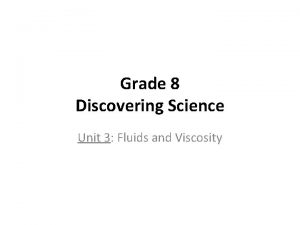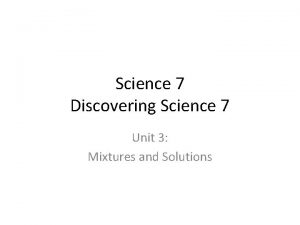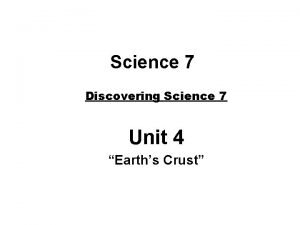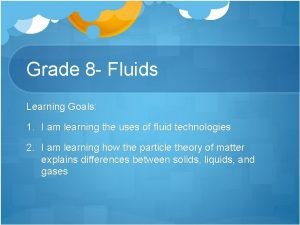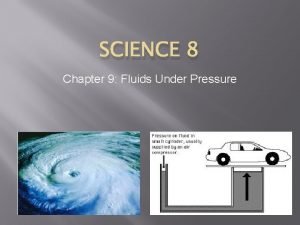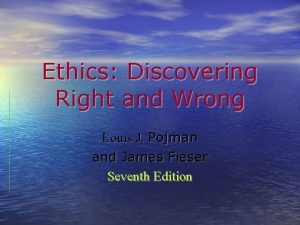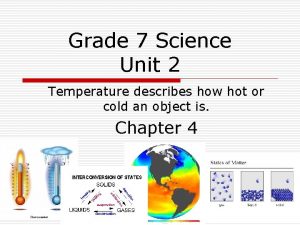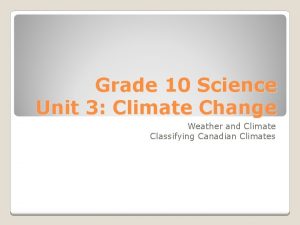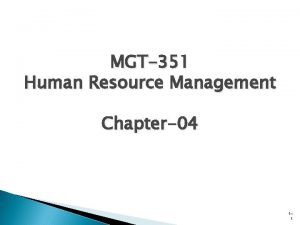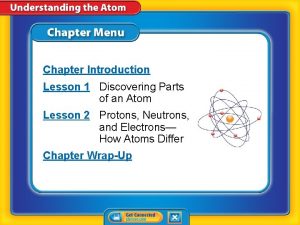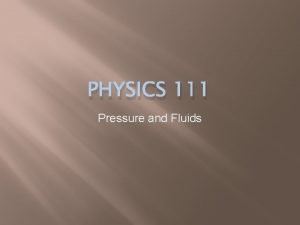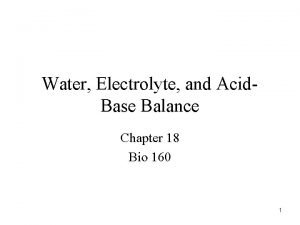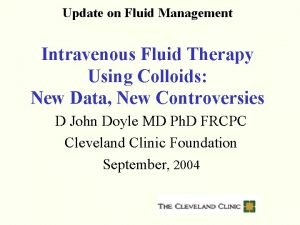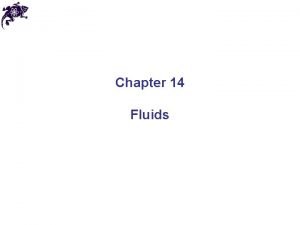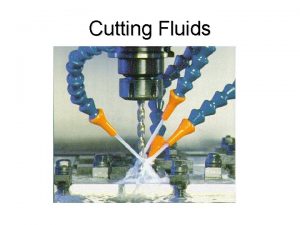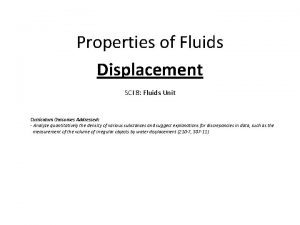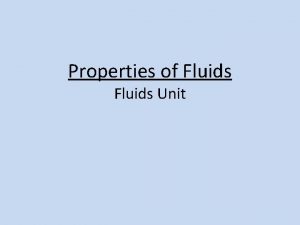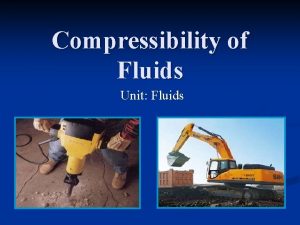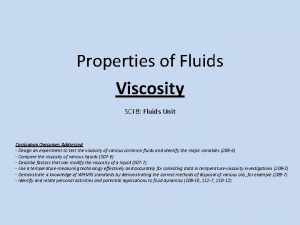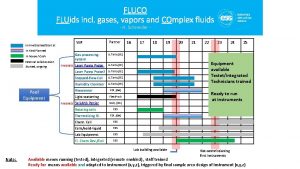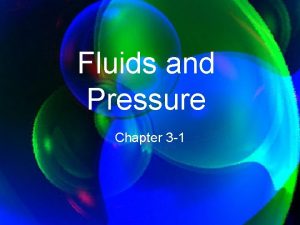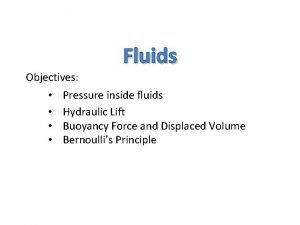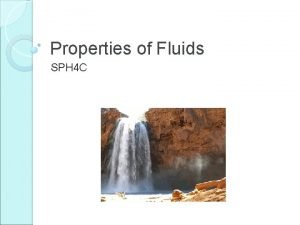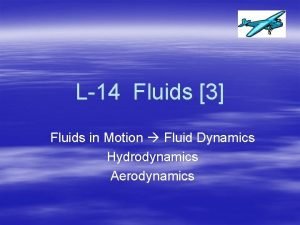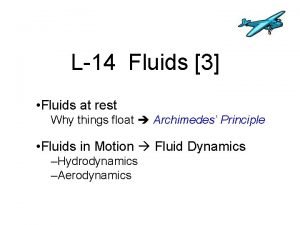Grade 8 Discovering Science Unit 3 Fluids and













































- Slides: 45

Grade 8 Discovering Science Unit 3: Fluids and Viscosity

Chapter 7 Viscosity describes a fluid’s resistance to flow.

QUESTIONS • Why do some fluids seem to hold their shape longer? • Why do some fluids take up more space than other fluids at different t temperatures? • Why do some fluids flow slowly while other flow quickly?

The Particles Theory • All matter is made up of particles. • These particles are constantly moving – they have energy. • There are spaces between these particles. • There attractive forces between the particles. • The particles of one substance differs from the particles of other substances.

The States of Matter Properties State Shape Solid Fixed Liquid Gas Volume Does not change Unfixed Changes Particle Arrangement Particle Movement Tight Vibrate Tight Flowing Loose Random


The Changing States of Matter • • Melting Freezing Evaporation Condensation Sublimation Deposition Ionization Deionization - Solid to liquid Liquid to solid Liquid to gas Gas to liquid Solid to gas Gas to solid Gas to plasma Plasma to gas

Changing States of Matter - Continued

Fluids • A fluid is anything that flows. • Example: Water, maple syrup, milk, motor oil, Cheese Whiz, compressed air in tires, . . .

Viscosity • The viscosity of a fluid is related to the amount of friction between particles Friction is the resistance to movement. • Viscosity describes how “thick” or “thin” something is. • Viscosity is how easily a fluid flows. Flow rate is the amount of fluid that flows past a point in a given amount of time

Examples Viscosity • Motor oil, in the winter, flowing from its container flows slow, but in the summer it flows fast. • Pancake syrup, just out of the refrigerator, flowing from the bottle flows slow, but when warmed up by placing it under warm water will flow fast. ** relate to the particle theory.

The particle Theory and Viscosity Several factors influence the viscosity of a fluid, they include: • Strength of attractive forces • Temperature variations • Concentration of the fluid • Particle size

Chapter 8 Density describes the amount of mass in a given volume of a substance

Density • Density is the amount of mass in a certain unit volume of a substance. • A bowling ball has a high density of particles in comparison to a balloon filled with helium gas or a glass of water. • * The particle theory, density and a thermometer.

Density cont. . . ** Solid objects can move easily through liquids and gasses, while gases and liquids find it difficult to travel through solids, if at all. • Gasses are less dense than liquids • Liquids are less dense than solids * Displacement is the amount of space that an object takes up when placed in a fluid.

Calculating Density, Volume and Mass • Density is the amount of mass in a certain unit volume of a substance. • Volume is a measurement of the amount of space occupied by a substance. • Mass is the amount of matter in a substance.


Calculating Density Formula: Word Problem: • Density (D) = Mass (m) / Volume (V) • Find the density of a substance with a mass of 25 g and a volume of 4 cm 3 D = m/V • D = m/V • D = 25 g / 4 cm 3 • D = 6. 25 g/cm 3

Calculating Volume Formula: Word Problem: • Volume (V) = Mass (m) / Density (D) • Find the volume of a substance with a density of 8. 5 g/ cm 3 and a mass of 34 g. V = m/D • V = m/D • V = 34 g / 8. 5 cm 3 • V = 4 cm 3

Calculating Mass Formula: Word Problem: • Mass (m) = Volume (V) x Density (D) • Find the mass of a substance with a density of 10. 2 g/ cm 3 and a volume of 3. 4 cm 3. m = VD • m = VD • m = 3. 4 cm 3 x 10. 2 g/ cm 3 • m = 34. 68 g

Density Changes in Everyday Life Examples: (Discuss) • A baking cake • Water (three states) • Warms and cool tire pressure • Drying wood • Hot air balloons • Salt water

Chapter 9 Forces influence the motion and properties of fluids

Force • A force is a “push” or “pull”. • A force can start an object to move or stop an object from moving. • A force can cause an object to speed up or slow down. • A force can change the direction of a moving object. • A force can be a bend, twist of squeeze. • An arrow is used to symbolize force


Types of Forces • Buoyancy • Magnetic • Gravity • Friction

Forces Balanced Forces: Unbalanced Forces: • Balanced forces are equal to each other and opposite in direction to each other. • Potential energy - stored energy; energy at rest. • One force is greater than another • Kinetic energy – energy in motion/

Mass vs. Weight Mass: Weight: • Mass remains the same no matter where an object is in the universe. • Weight is the measure of the push or pull, of gravity on an object. • Weight is measured in units of Newton (N). • The weight of an object on the moon is 1/6 of that on Earth. A 600 N person would weigh 100 N on the moon.

Buoyancy – The “Anti-Gravity” Force • Buoyancy is the upward force of an object that is submerged or floating in/on a fluid. • In other words buoyancy is the upward push of a substance away from the natural pull of center of the Earth.

Objects Which Have Buoyant Forces Acting Upon Them • • • Boat Hot air Balloon Airplane Swimmer Parachutist

Archimedes’ Principle • The buoyant force acting on an object equals the weight (force of gravity) of the fluid being displaced by the object. • If the force of gravity pulling down on an object is equal to the amount of buoyant force pushing up then the object is said to have neutral buoyancy; it will neither rise or sink.

Salt Water vs. Fresh Water • Fluids with high density (particles are closer together) exert a greater buoyant force than fluids with low density (particles farther apart from each other). • Example: Salt water is more dense than fresh water, therefore, object is salt water will float better than is fresh water.

Design Influences an Object’s Ability to Sink or Float • Concrete or steel boat vs. a chunk of concrete or a section of steal. • A silk/canvass hot air balloon vs. a sheet of canvass. • Submarine vs. an iron pole.

Average Density • The average density of an object is the total mass of all substances that make up the object divided by the total volume of the object. • Ships can be built of steel because the haul of the ships can be constructed large enough to ensure the density of air in the haul is low.

Pressure • Pressure is the force acting on a certain area of a surface. • Example: When you place your finger on a bruise, you are applying pressure to that specific area. You are not applying pressure to your ankle, . . . Just the bruise.

Force, Area and Pressure Two General Conclusions 1. ) The larger the force, the greater the pressure. 2. ) The smaller the area, the greater the pressure.

Calculating Pressure Formula: • Pressure is calculated by measuring the force that is being exerted on an object and dividing it by the area over which the force is being exerted. • Pressure (P) = Force (F) / Area (A) P=F/A • Pressure is measured in units of pascals (Pa) Word Problem: • A serving jug hold 500 N of Kool-Aid. If the base of the serving jug is 0. 05 m 2, what pressure does the Kool-Aide exert on the base of the serving jug? P=F/A P = 500 N / 0. 05 m 2 P = 10 000 Pa

Calculating Force Formula: Word Problem: • Force (F) = Pressure (P) x Area (A) • If 63 000 Pa of pressure is being exerted on a rubber ducky with a area of 0. 09 m 2, how much force is being exerted on the rubber ducky? • F=Px. A • F = 63 000 Pa x 0. 09 m 2 • F = 5670 N F=Px. A

Calculating Area Formula: Word Problem: • Area (A) = Force (F) / Pressure (P) • If 500 N of force is being exerted on a balloon creating pressure of 1600 Pa, what is the area of the object? • A=F/P • A = 500 N / 1600 Pa • A = 0. 3125 m 2 A=F/P

Pressure, Volume and Temperature • Increasing the temperature of a gas increases the volume of the gas (pressure being held constant). • Increasing the temperature of a gas increases the pressure of the gas (volume being held constant). • Increasing the pressure of a gas decreases the volume of a gas (temperature being held constant).


Compression vs. Incompressibility • Compression The ability to squeeze into a smaller volume. ex. Aerosol cans • Incompressibility The inability to squeeze into a smaller volume. ex. Try squeezing a unopened 2 l Pepsi bottle. What happened… did not happened?

Pascal’s Law • Pascal’s law states that pressure applied to an enclosed fluid is transmitted with equal force throughout the entire container. Discuss: • Compressed air • Propane cylinders • Aerosol cans

Application of Pascal’s Law • A car lift • An hydraulic jack • Automatic breaking system

Hydraulics vs. Pneumatics • Hydraulics is the study of pressure on “fluids”. • Pneumatics is the study of pressure on “gases”.

New Technologies Hydraulic System Pneumatic System • Devices which exerts/transmits force on a continuous, enclosed liquid. • Examples: dentist chair, dump truck, loaders, car lifts, human circulatory system. . . • Devises which exert/transmits force on continuous enclosed gas. • Examples: Air compressors, jack hammers, air nail gun, . . .
 Discovering science 8
Discovering science 8 Pure substances
Pure substances Rock vs mineral
Rock vs mineral Discovering science 7
Discovering science 7 Fluids grade 8
Fluids grade 8 Science 8- fluids under pressure worksheet answer key
Science 8- fluids under pressure worksheet answer key Pure substance examples
Pure substance examples Ethics discovering right and wrong
Ethics discovering right and wrong What is her favourite subject?
What is her favourite subject? Which of the following adaptations helps birds fly?
Which of the following adaptations helps birds fly? Grade 7 science unit 2
Grade 7 science unit 2 Grade 8 science unit 4
Grade 8 science unit 4 Grade 10 science unit 3
Grade 10 science unit 3 Eeo compliance in job analysis
Eeo compliance in job analysis Discovering the humanities 3rd edition
Discovering the humanities 3rd edition Discovering computers 2018 ppt
Discovering computers 2018 ppt Discovering computers 2016
Discovering computers 2016 Discovering computers 2018 chapter 1
Discovering computers 2018 chapter 1 Important of self motivation
Important of self motivation P value in statistics
P value in statistics Discovering economic systems guided practice
Discovering economic systems guided practice Discovering computers 2011
Discovering computers 2011 Self motivation quiz
Self motivation quiz Discovering computers 2018 chapter 1
Discovering computers 2018 chapter 1 Muhamed computer technology
Muhamed computer technology Discovering engineering
Discovering engineering Discovering american ideals in primary sources
Discovering american ideals in primary sources Teachers discovering computers
Teachers discovering computers Amenhotop
Amenhotop Discovering personal genius
Discovering personal genius What is tactile output
What is tactile output The system generates regular electronic pulses
The system generates regular electronic pulses Chapter 7 lesson 1 discovering parts of an atom answer key
Chapter 7 lesson 1 discovering parts of an atom answer key Discovering the internet
Discovering the internet Discovering cells
Discovering cells Discovering our past ancient civilizations
Discovering our past ancient civilizations Solids liquids and gases section 2 properties of fluids
Solids liquids and gases section 2 properties of fluids Compressible and incompressible fluids
Compressible and incompressible fluids Australian standards for texture modified foods and fluids
Australian standards for texture modified foods and fluids Compressible and incompressible fluids
Compressible and incompressible fluids Why are liquids incompressible
Why are liquids incompressible Physics fluids practice problems
Physics fluids practice problems Chapter 18 fluids and electrolytes
Chapter 18 fluids and electrolytes Unit 6 review questions
Unit 6 review questions 4 2 1 rule fluids
4 2 1 rule fluids Learn composition of various synthetic bases
Learn composition of various synthetic bases
